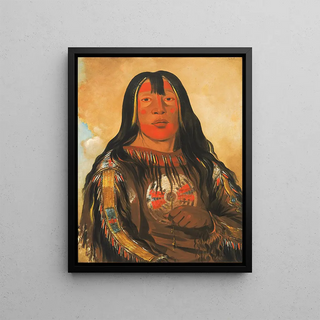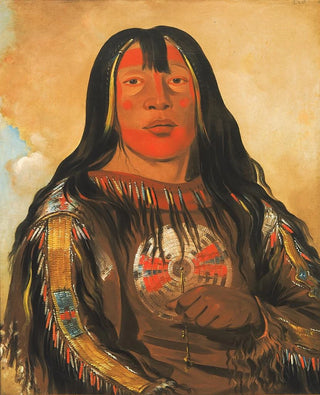Art print | Peh-Tä-Pe-Kiss Eagles face a Piegan chief - George Catlin


View from behind

Frame (optional)
In the vast panorama of art history, certain works stand out for their ability to capture the essence of a time and culture. The art print Peh-Tä-Pe-Kiss Eagles affronte un chef Piegan - George Catlin is one of these iconic pieces. Painting in the mid-19th century, Catlin dedicated himself to documenting the lifestyles of Indigenous peoples of America, offering a valuable and poignant visual testimony. This piece, both narrative and symbolic, immerses us in a moment of cultural confrontations, where the artist succeeds in immortalizing the strength and dignity of the figures he depicts, while revealing the inherent tensions of their era.
Style and uniqueness of the work
Catlin's style is characterized by meticulous attention to detail, a vibrant color palette, and a dynamic composition. In Peh-Tä-Pe-Kiss Eagles affronte un chef Piegan, each element of the artwork is carefully arranged to create a scene that is both dramatic and evocative. The expressions of the characters are full of life, reflecting the determination and bravery of the warriors. Catlin employs painting techniques that emphasize movement, as evidenced by the postures of the figures that seem almost to emerge from the canvas. This art print does not merely depict an encounter; it also evokes themes of pride, resistance, and cultural identity. The artist manages to establish a visual dialogue between the protagonists, inviting the viewer to reflect on the stakes of this face-to-face.
The artist and his influence
George Catlin, often regarded as a pioneer of ethnographic art, dedicated his life to documenting Native American cultures at a time when these were threatened by colonial expansion. His work not only helped preserve a visual memory of the peoples he encountered but also paved the way for a better understanding of their cultural richness. Catlin traveled across the United States, creating portraits, landscapes, and scenes of daily life, while forging connections with the communities he painted. His humanist and respectful approach inspired

Matte finish

View from behind

Frame (optional)
In the vast panorama of art history, certain works stand out for their ability to capture the essence of a time and culture. The art print Peh-Tä-Pe-Kiss Eagles affronte un chef Piegan - George Catlin is one of these iconic pieces. Painting in the mid-19th century, Catlin dedicated himself to documenting the lifestyles of Indigenous peoples of America, offering a valuable and poignant visual testimony. This piece, both narrative and symbolic, immerses us in a moment of cultural confrontations, where the artist succeeds in immortalizing the strength and dignity of the figures he depicts, while revealing the inherent tensions of their era.
Style and uniqueness of the work
Catlin's style is characterized by meticulous attention to detail, a vibrant color palette, and a dynamic composition. In Peh-Tä-Pe-Kiss Eagles affronte un chef Piegan, each element of the artwork is carefully arranged to create a scene that is both dramatic and evocative. The expressions of the characters are full of life, reflecting the determination and bravery of the warriors. Catlin employs painting techniques that emphasize movement, as evidenced by the postures of the figures that seem almost to emerge from the canvas. This art print does not merely depict an encounter; it also evokes themes of pride, resistance, and cultural identity. The artist manages to establish a visual dialogue between the protagonists, inviting the viewer to reflect on the stakes of this face-to-face.
The artist and his influence
George Catlin, often regarded as a pioneer of ethnographic art, dedicated his life to documenting Native American cultures at a time when these were threatened by colonial expansion. His work not only helped preserve a visual memory of the peoples he encountered but also paved the way for a better understanding of their cultural richness. Catlin traveled across the United States, creating portraits, landscapes, and scenes of daily life, while forging connections with the communities he painted. His humanist and respectful approach inspired






